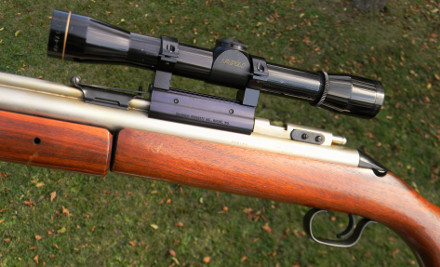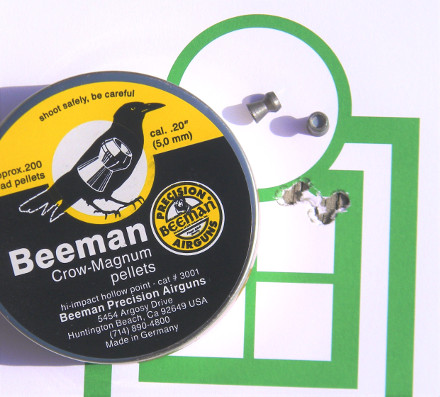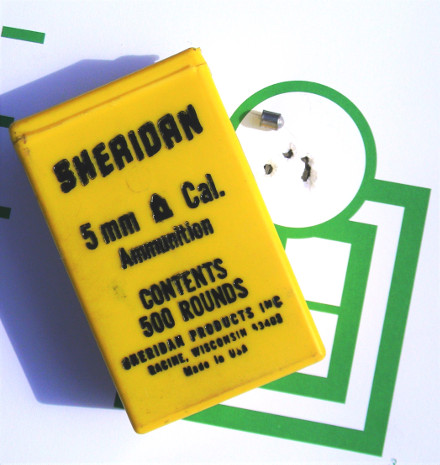
I remember in my early teens feeling pretty “cool” with my Remington pump action styled Daisy BB gun. It was about the nicest one on the block until one day I saw “IT.” Now about forty years later, I realize a basic fundamental rule of life. And that is, no matter what you have, some kid down the block has a nicer, bigger, faster, and better one. One day when I stepped into my neighbor’s garage across the street, the 30 year old man happened to be shooting a pellet rifle in his garage.
He was shooting at a section of 1x4” pine, and the lead pellet was burying itself deeply into it. It was not a single pump gun. He told me how he normally shoots it with four pumps… but it can take up to eight pumps for even more speed! He and his dad had taken birds, squirrels, and even rabbits with it. Long ago I’d learned to not even shoot at wood with my BB gun because it didn’t have enough power to dig in, but would ricochet off to who knows where at the shot. So he had an air RIFLE… while I just had a toy…I felt so inadequate!
He was shooting a very early Sheridan C series pneumatic 5mm/.20 caliber lead pellet air rifle that had once been his dad’s. Made in Racine, Wisconsin, it had a rifled brass barrel and a nickel plated bolt. It had a two piece walnut stock, looking a lot like the classic Mannlicher-Schoenauer carbine. To shoot it, grab the rear end of the forend, drop and swing it down and forward, then pump it back into position, charging the rifle with compressed air. After at least four pumps, lift and cock the bolt rearward, place a pellet into the loading gate, then push the bolt forward to chamber the pellet, aim and fire.
I was familiar with .177 and .22 caliber air rifles, but this unique 5mm was new to me. He showed me the cylindrical solid pellet- not a flimsy hourglass shape like the other calibers, extolling the virtues of the Sheridan pellet and how deeply it can penetrate. After hearing a few of his stories of the pests and small game he’d taken, I was hooked. He showed me the small cylindrical metal tin the special pellets came in, looking to me like a giant version of the 5mm pellet itself. I just had to get one… until I found out it costs around THREE TIMES what my BB gun did- that was just out of the question!
It wasn’t until a few years later when I got my first .22 that I placed the Sheridan back in a deep corner of my mind; now...
that I had a REAL gun. Then one day while buying a brick of .22s at K-Mart, I looked up and saw a Sheridan pellet rifle on the rack behind the clerk. It was the early 70’s, and as best as I can remember, had a price tag of about $60- around double what other pellet guns of that time were selling for. No longer interested in “just a pellet rifle” for me, I thought it’d make a great gift for my younger brother Gary, who was just 13 or so. He was too young for a gun, especially in the Chicago suburbs where we lived, but this should be a lot of fun for him. I left the store with a Sheridan Blue Streak Model C, a couple yellow plastic rectangular “tins” of the unique pellets, and an inexpensive,felt-lined plastic soft case for him to store it in.

Chapter 1: The Best Gift
Click to LOAD DATA SHEET
My brother was thrilled at his new gift, oohing and aahing as he sat on the couch in the living room where I presented him with his new Sheridan 5mm air rifle. We immediately set out through the kitchen, down the back porch stairs and set up a cardboard box target to get sighted in. While he was captivated, I soon grew tired of it, leaving him to pump and plink. He sighted it in dead-on at 50 feet with four pumps using the early cylindrical Sheridan pellets noted for great penetration.
We lived behind a shopping mall with an alley behind the stores closed off to our backyard by a basket weave redwood fence. The weave portion was only 3/8” thick, and he soon discovered the Sheridan could easily whistle right through there! And the alley was lit by simple light fixtures every 100 feet or so. The aluminum spun shades that covered the screw-in bulbs, even though at around 35 yards, could easily be hit by him, causing no permanent damage, just dents in the soft aluminum.
While songbirds were never targets, Gary soon found the 5mm pellets to be deadly on starlings. In no time at all, any such bird landing in the back yard was...
not safe. He also got a swinging metal target and soon realized it offered no challenge at all. Over the years, dozens and dozens of the familiar yellow plastic rectangular Sheridan 5mm pellets were run through his air rifle. It got to where he rarely ever missed what he was aiming at. Over forty years later, he still has that rifle, and it shoots as well as ever.

Recently, we started shooting it again, and it prompted in me the desire to have one of my own. A website search revealed a very good condition Silver Streak model from almost the same period. It was just like his Blue Streak, but the gun had been satin nickel coated. Curious as to how they might compare, I set up my chronograph in the back yard and was amazed that the two 40+ year old pellet rifles produced nearly identical velocities at various pumping levels. Seeing that, the handloader came out in me, so I became determined to scope mine and see what velocities and accuracy could be achieved with it by shooting seven different types of pellets.
Chapter 2: One-thousand, fifty pumps!
For my testing, I assembled seven different 5mm pellets including three from Sheridan. Those tested included the Beeman Silver Bear with a small hollow point weighing only 9.8 grains. The German H&N Match wadcutter, coming in at 10.2 grains, and the copper flashed Beeman Double Gold round nose, heavier still at 11.6 grains. Next was the very long Crow Magnum from Beeman, having a considerable hollow point, and weighing 12.7 grains.
From Sheridan, my brother still had a yellow plastic container of the original cylindrical heavy pellet from Racine, Wisconsin… at a whopping 14.4 grains, still having a price tag on it of only $3.55 for 500 pellets. After that series, also from Racine came the red plastic box of Diabolo pellets, with a traditional round nosed profile and weighing 14.3 grains. Finally, the yellow box came back again, as a Benjamin/Sheridan product from New York, but now, many years later, with a sticker price of $10.99! Labeled as a “cylindrical pellet,” it did in fact have a slight waist, and the sharp cutting, leading edge...
was now smoothed and rounded. It too weighs in at 14.3 grains. In all my years, I’d never read a detailed report of what a Sheridan 5mm pellet gun was capable of, but I was now about to find out- let the testing begin!
First though…let’s do the math… five shots with each pellet type, at four pumps, five, six, seven, and finally eight pumps. So (5 x 4) + (5 x 5) + (5 x 6) + (5 x 7) + (5 x 8) = 150 pumps to test just one pellet. Then repeating all of this for the remaining six types of pellets equals one-thousand, fifty pumps of my Sheridan for velocity and accuracy testing. I was so happy when this testing ended!

I was able to find an original Sheridan Intermount two-piece base and original 1” rings. The base securely clamps onto the barrel just behind the rear sight. I chose to scope it with a size-appropriate Leupold, a crystal clear M8 4x Compact model I’ve had for decades. A Competitive Edge Dynamics CED M2 chronograph was set up at the range, and my targets were posted at 50-feet. As the first tin of pellets came out, I started pumping, and pumping, and pumping…
Chapter 3: Speed and Accuracy Results
Due to the great humidity in Pennsylvania, my portable target backer is 2” rigid foam insulation, as it keeps my targets nice and dry. Deciding to shoot the H&N Match pellet first, I charge the gun with four pumps, load a pellet and fire. I hear a funny sound, but no pellet strikes the target. Is it possible the pellet didn’t exit the barrel? So I give the gun four more pumps, point it at the ground and pull the trigger. Now a pellet impacts the dirt, kicking up some small rocks. What the heck just happened???
So I give my Sheridan four more pumps, load a pellet and again fire at the target. I hear the pellet smack the rigid foam, but no hole appears in the paper… what’s going on?
Walking down to examine my target, I can see where the pellet struck, but the paper is barely torn- it didn’t even make it through the paper- I’m so confused! Sitting back down at the bench, I start looking very closely at the pellets. The skirt...
seems a little heavy, so perhaps four pumps is not producing enough gas pressure to cause the skirt to expand and seal off the rifling, allowing much of the gas to blow by. This would result in lower speeds, probably the reason the paper was barely torn at 50 feet. One more try, and while my chrono registers 557 fps, I decide to stop testing this pellet at only 4 pumps, and move on to five.

BINGO! My first group is right around 5/8” for five shots with speeds of 603 fps from the H&N Match pellet. Amazingly, accuracy drops to just over one-half inch at 6, 7, and 8 pumps, with the top load giving me 684 fps, 10.6 ft. lbs., and 0.53” groups. This pellet with the wide flat nose would be great for smaller pests at that speed and accuracy level. It also leaves nice, clean holes in the target, making all my shots easy to see through the 4 power Leupold.
The slightly lighter Silver Bear hollow point at 9.8 grains was best with 7 pumps for 0.56” five-shot groups at 666 fps. With its frontal profile, it would be just as good as the H&N Match for small pest control. In fact, one three- day holiday weekend, I took 14 field mice out from under my bird feeder using only four pumps and shooting out to 30 feet with open sights. All mice dropped to the shot, giving me satisfying one-shot stops. Honestly, it was as much fun as busting a prairie dog at two hundred yards with a .223!
The copper flashed Double Gold round nosed pellet, weighing in at 11.6 grains, shot best at 4, 7, or 8 pumps, at speeds of just over 500 fps… to almost 660. All three of these combinations shot into just over a half inch at 50 feet. The heavier still Crow Magnum at 12.7 grains loved five pumps for 543 fps, delivering a nice half-inch five shot group. While it did get up to 616 fps with 8 pumps, group size opened up to three-quarters inch.
But walking up to my target revealed an interesting discovery- every Crow Magnum was slightly keyholing, showing a hard clean cut where they’d impacted, and then a slight tear where the pellet skirt was striking slightly sideways. I do believe as a Magnum pellet, it was intended for the single stroke piston guns...
which can push it to over 900 fps. At the slower speeds from the Sheridan, the very long Crow was not fully stabilizing, but it was still fairly accurate. As such, I would not recommend them in the Sheridan.
A real surprise was the across-the-board accuracy of the 14.3 grain Sheridan Diabolo round nosed pellets from the red plastic box. Groups ran from only 0.48 to 0.58 with 7 pumps being the most accurate while producing 561 fps. My best group of the day was with the later generation Sheridan cylindrical pellets having a slight waist and rounded nose. Six pumps created 539 fps and great accuracy at only a 5-shot group size of 0.45”.
Lastly tried was the precious, almost full yellow plastic box of original Sheridan true cylindrical pellets which had given the 5mm Sheridan pellet rifle its longstanding notoriety and legend-like status. Four or five pumps produced 428 or 465 fps and grouped into 0.52 and 0.47” for five shots at 50 feet. With pellet rifles nowadays delivering over 1,000 fps… that does not seem very impressive. But the number of pests my brother dropped in a “lights-out” fashion would amaze you as it always did me.
Summary
Some may say, “But he only shot one 5-shot group with each combination. He should have fired at least two or three to get a better indication of accuracy!”
Well, I look at it this way. One-thousand and fifty pumps on my Sheridan is a good base for shooters to at least get an idea of how their thirty, forty, or fifty year old Sheridan can perform on a variety of pellets. Back then, nobody had a chronograph to even know how fast our guns were shooting; we just knew they dropped pests like a hammer.
So break out your old Sheridan… or track down an old one that someone else is foolish enough to let go of, for currently three to five times what they paid for it new long, long ago. My Silver Streak is a rare bird which I only could’ve lusted for forty years ago. Now that I have one in my hands, shooting it makes me feel like I’m thirteen again. That alone is priceless to me.
Now if I could only find a like-new, olive green, motorized Remco Army Bulldog Tank from the early sixties, capable of actually firing projectiles… my life would be complete! And, I would have the nicest TANK on the block!!!